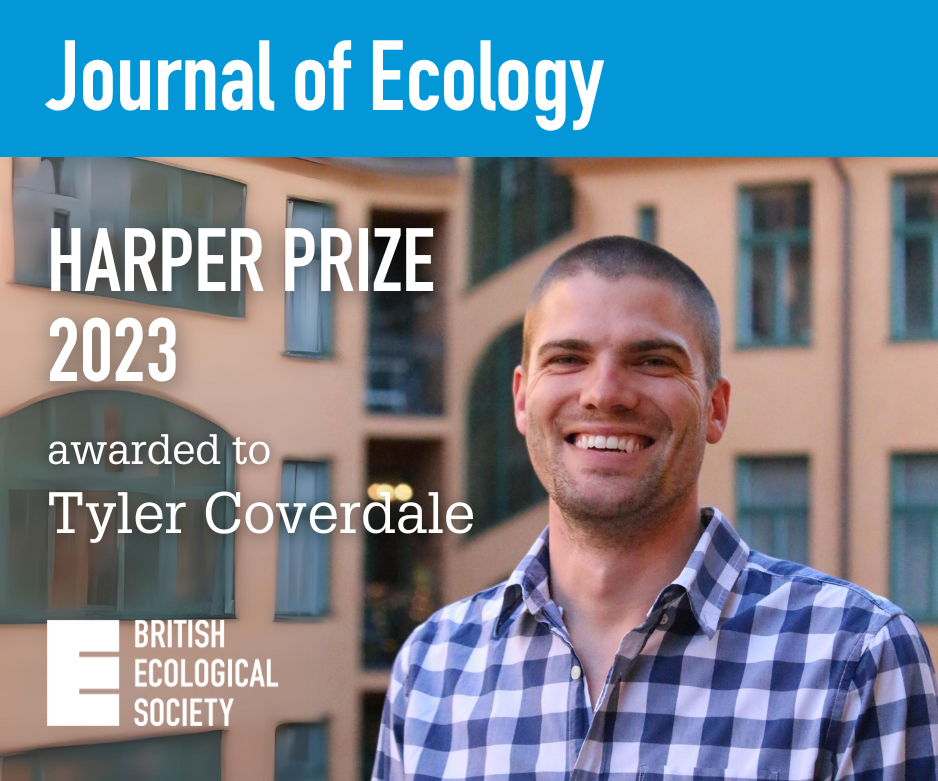|
Getting your Trinity Audio player ready...
|
We’re delighted to announce that the winner of the 2023 Harper Prize is Tyler Coverdale! The Harper Prize is awarded annually for the best paper published in the journal by an early career researcher.
Winner: Tyler Coverdale
“As Tyler´s succinct review points out, we have examined the consequences of vertical structural complexity (VSC) in many ecosystems but have paid less attention to the actual mechanisms for the variation in VSC. Until now. Tyler explores how remote sensing tools document the variation in vertical structuring of canopies, and how VSC relates to ecosystem function. The presented evidence suggests a predominantly positive relationship between plant species diversity and VSC, emphasizing an underappreciated aspect of phytodiversity which may increase structural complexity, ecosystem stability and resistance and resilience to disturbance and global change” – Amy Austin (Senior Editor, Journal of Ecology)
In this blog post, we ask Tyler some questions about his research and career to date:
⭐️ Tell us a bit about how you got into ecology?
I started my undergraduate studies convinced that I would major in history, but after a couple false starts I found myself in an introductory ecology class. I had no idea what ecology was but loved learning about it, but the biggest thing I took away from the course was that there were people in the world who actually got to travel the world, spend time in the field, and study ecology for a living. I never took another history class and have been involved in ecological research ever since. It was the most impactful class that I’ve ever taken, and now I’m lucky to be teaching a similar course at Notre Dame.
⭐️ Can you summarise your winning paper and how it advances the field?
Structurally complex habitats tend to support more biodiversity. Vegetation structural complexity—the three-dimensional distribution of vegetation in an ecosystem—similarly affects a variety of ecologically and economically important functions, including regulating microclimate, influencing animal movement, and enhancing ecosystem productivity and carbon storage. Accordingly, restoration of vegetation structure has been identified as a potentially useful management tool, particularly for habitats like agricultural lands that have been homogenized by human activity. Identifying the best approach(es) for increasing structural complexity hinges on understanding the relationship between plant community composition and physical structure: are the highest levels of complexity attained with just a few plant species? Or are more diverse plant communities more structurally complex?
Using data from 29 studies that used active remote sensing to quantify vegetation structure, we found that vegetation structural complexity was nearly always higher at sites with greater plant diversity. For a subset of these studies that measured complexity across multiple levels of plant diversity, we showed that biodiversity-structural complexity relationships were most often positive and saturating (with all others increasing linearly), suggesting that there is at least some functional redundancy in species’ contributions to structural complexity. These results suggest that the restoration of biodiversity and vegetation structure are compatible management goals, and that they can be simultaneously achieved by facilitating the establishment and persistence of diverse plant communities.

⭐️ What did you enjoy most about conducting this study?
This was my first time conducting a quantitative review, so the whole experience was new and interesting. The idea that structural complexity might follow typical biodiversity-ecosystem functioning relationships (where more diverse communities tend to have a higher level of functioning, in this case structural complexity) is new, so we truly weren’t sure what we would find when we set out to do this study. As the data came in and we began to analyze it, it became clear that this was a general trend that held across many ecosystems and in many different management and restoration contexts. That’s always an exciting result, and it’s motivated a lot of the work that my lab is currently doing!
⭐️ Did you come across any problems or surprising discoveries when conducting this study?
The one that comes to mind is the sheer number of terms that researchers use to refer to vegetation structure. It was challenging to identify relevant studies because there are so many terms used interchangeably, and many of them are similar or identical to terms that ecologists use for other ideas: for example, there’s a big difference between plant structure (the physical arrangement of plant biomass) and plant community structure (the diversity and abundance of different types of plants). Conversely, stand complexity, canopy structure, and plant architecture might all mean the same thing.
⭐️ Have you continued this research and if so, where are you at now with it?
One of the limitations we noted in our study was that most research on vegetation structural complexity comes from fairly low diversity tropical and temperate forests; much less is known about the structure of non-forest ecosystems. To address this, we recently paired high-resolution LiDAR data with long-term plant composition data from a long-term savanna herbivore exclosure study in Kenya. Consistent with the results of our review, we found that more diverse savanna plant communities tend to be more structurally complex; in this particular savanna, the plant community comprised more than 400 species of understory plants and several dozen species of trees. Unlike the studies in our review, the relationship between plant diversity and structural complexity in this savanna was strongly shaped by large mammalian herbivores. Overall, plant diversity and structural complexity decreased with increasing herbivory pressure, but the herbivores responsible for these changes were different for the overstory and understory plant communities: elephants and giraffes had the strongest effects on the diversity and structure of the tree layer, while smaller-bodied species like impala and dik-dik had comparable effects in the short-statured herbaceous layer. Following this study, we are continuing to expand our research on biodiversity-complexity relationships in different systems, with an eye towards understanding how to leverage structural complexity for ecosystem restoration and conservation.
Find the winning article: ‘Unravelling the relationship between plant diversity and vegetation structural complexity: A review and theoretical framework‘, as well as the shortlisted papers for the 2023 Harper Prize in this virtual issue.

